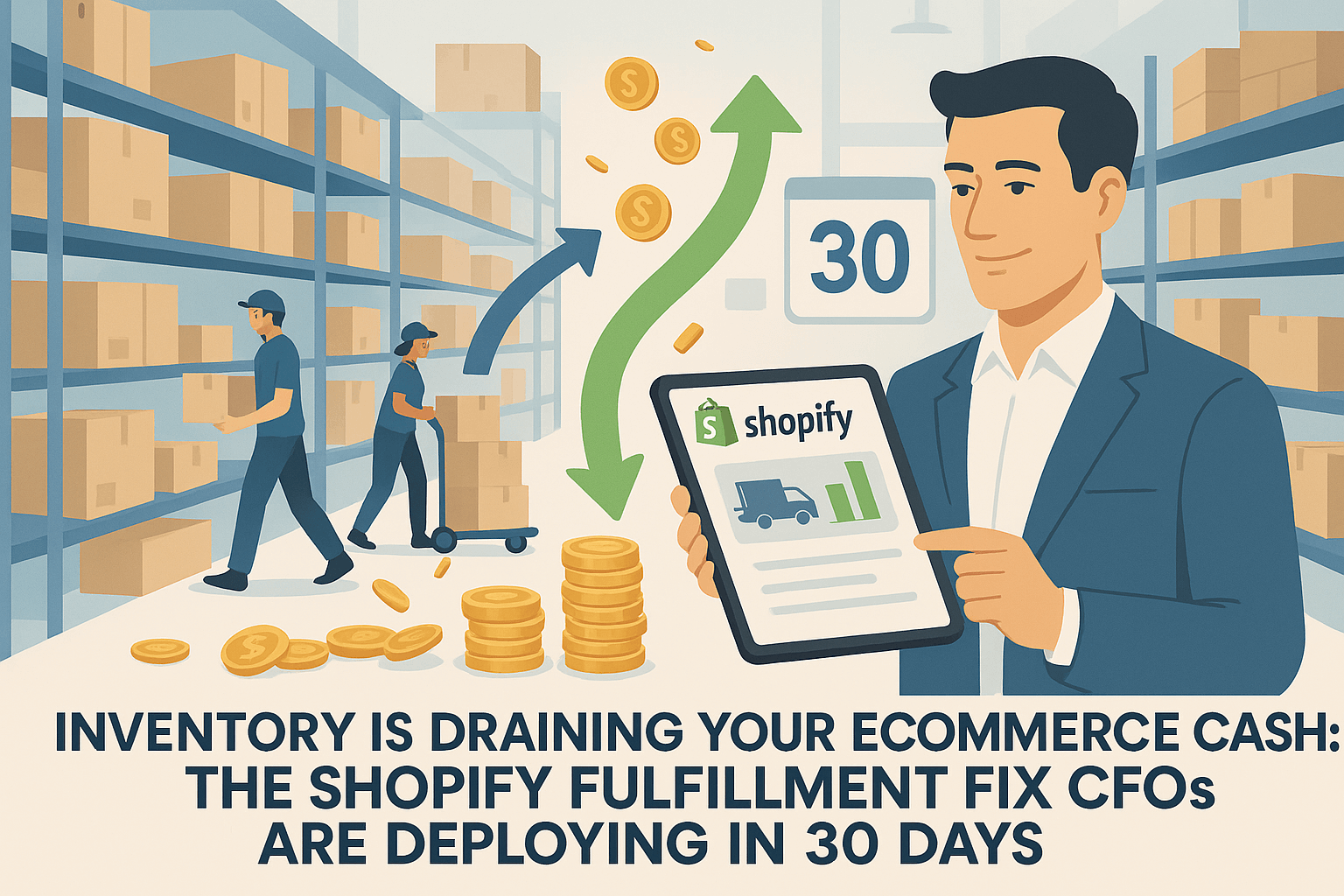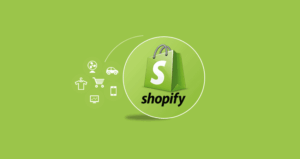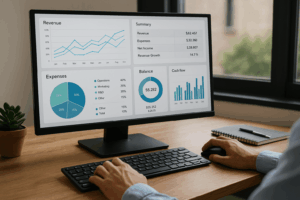If you’re a CFO at a mid-market Shopify brand, chances are you’re caught in the quiet war between resilience and cash flow. You’ve done what the post-COVID playbook told you to do—diversify vendors, build buffers, stay ready for volatility—but now your capital is trapped in racks, your warehouses are bloated, and your team is still missing SLAs. You’re not just overstocked. You’re over-committed. And the cost is creeping silently across your balance sheet.
This article isn’t about theory. It’s about execution. How smart operators are using API-based routing, SKU-level modeling, and hybrid fulfillment systems to unlock liquidity—without overbuying, replatforming, or gambling on guesswork. If you’re trying to stretch every dollar of inventory into actual delivery performance, this is the real blueprint.
The CFO’s Dilemma — Resilience vs. Cash Flow
Every CFO I know has lived some version of this nightmare.
You’re sitting in a 7 p.m. finance review, staring at a warehouse dashboard that says “plenty in stock,” and your ops team just called, you’re out of the product in your West Coast DC.
You finally line up vendors, secure backup lanes, and pad your safety stock, only to look up a month later and realize your capital’s frozen in racks no one’s touching
You followed the playbook. Added redundancy. Piled on safety stock. Checked the box with vendor diversification, just like the board asked.
But all you did was shift the stress. Now you’re not worried about service levels—you’re watching your liquidity drain into warehouse racks. It’s the classic ecommerce cash flow squeeze—where healthy net income masks negative cash flow due to bloated inventory and delayed accounts receivable cycles. And the worst part? You can’t even say it’s broken, just expensive, bloated, and one cycle away from biting you again.
This is the quiet crisis hiding inside most “resilient” supply chain strategies today.
Because let’s be real, you’re not Amazon. You’re not Nike. You don’t have float to play with or a treasury team spinning hedges in the background.
You’re in the middle tier. Fast-moving. Margin-sensitive. Running on precision, not abundance.
Redundancy feels wise—until the second PO guts your runway.
The False Binary of Supply Chain Strategy
After 2020, every procurement call turned into a crisis planning session. The COVID-era supply chain shock rewired everyone’s instincts—overnight, redundancy went from a luxury to a lifeline. And really, who could blame them? Ports stalled without warning. Freight lanes vanished overnight. Tier 2 vendors disappeared mid-cycle like they were never there.
So companies did what felt smart. They reacted hard. First came the backup suppliers. Then the overbuying. Then a third vendor, just in case the second blinked. The playbook shifted from just-in-time to just-in-case. And for a while, it felt like the right call.
But now it’s showing up on the wrong side of the ledger. Pallets are stacked in overflow storage. Invoices are stacking faster than velocity. Warehouses full of “resilience” that no one’s moving. And the cash? It’s not gone, but it’s certainly not working.
What makes it worse is this: most CFOs already see it. They know the model is bloated. They know they’re holding too much. But fixing it feels like choosing between speed and survival. Cut the stock, and you miss fulfillment windows. Cut the backup vendors, and you lose ops credibility and customer trust. So they freeze—or worse, they spend more, dressing it up as redundancy theater.
The logic gets defensive fast: “Sure, we’ve got five months of inventory. But at least we’re protected if our offshore lead time slips.” And the reality no one says out loud? “We’ve tied up $3.4 million in product that might not move for 90 days. And now our Q3 budget is toast.”
That’s the real tension point. Service level on one side. Capital efficiency on the other. And every mid-market CFO is walking that narrow edge, trying not to fall off either cliff.
What Got You Here Won’t Get You Through
Before 2020, supply chain strategy was mostly math. You negotiated harder with suppliers. Trimmed freight costs. Tuned your reorder logic like a spreadsheet symphony — and it worked. The system was stable, the inputs were predictable, and efficiency ruled the day.
But that era is over. Today’s environment is nonlinear, unstable, and punishing. Demand spikes on a Tuesday. A key carrier ghosts on a Friday. Your New Jersey warehouse is overflowing while your California DC is running on fumes. You’re not managing a supply chain anymore, you’re navigating a volatility loop.
And here’s the hard truth: you can’t buffer your way out of this. No amount of safety stock will fix mismatched timing, unpredictable regional demand shifts, or the lag between when a PO gets placed and when a customer clicks “buy.” The tools that once gave you control, spreadsheets, instincts, and static forecasts, now leave you exposed.
What you need isn’t more stock. It’s a system that adapts. That means shifting from static supply buffers to dynamic decision systems that actively improve cash flow while maintaining operational resilience—a shift that enables healthy cash flow without overbuilding inventory buffers. A model that moves with volatility instead of resisting it. One that lets you dual-source with discipline, without doubling your inventory or locking up capital in racks that no one’s touching.
Because today, success isn’t about being right all the time. It’s about staying cash-aware 95% of the time, and being fulfillment-capable exactly when it counts. The winners aren’t the ones who plan perfectly — they’re the ones who adjust intelligently.
That’s the turning point we’ve helped mid-market DTC and B2B brands make. From reactive planning to system-led agility. From gut feel to instrumentation. From redundancy as insurance to redundancy as a balance sheet strategy.
Because sourcing diversity isn’t Plan B anymore. It’s a capital lever that models, routes, and executes with real-time overlays that let you see risk coming and shift before it hits.
The Cash Flow Model — Domestic vs. Offshore Inventory Mix
On paper, “dual-sourcing” sounds like a strategic masterstroke. Two vendors. Two lanes. Two sets of MOQs. It checks the resilience box, earns a nod from the board, and looks solid in a slide deck.
But when you’re the CFO staring at cash flow models? It reads like a trap.
Because now you’re expected to keep both supply lanes moving — without doubling your inventory, choking working capital, or blowing your fulfillment SLAs. That’s a high-wire act, and most mid-market companies fall into one of two broken defaults. Without structured cash flow management, every dual-source decision adds hidden pressure to the balance sheet—even when the top-line income looks strong.
They overcommit to offshore and pray the port doesn’t back up.
Or they lean too hard into domestic and watch margin disappear in a puff of expedited freight and inflated unit costs.
The smartest operators don’t pick a side — they build a system. A hybrid sourcing model that doesn’t just weigh landed cost or lead time. They model cash velocity. Service level thresholds. SKU-level flexibility across regions. And they let the math guide the mix.
Want to know what your sourcing mix is really costing you — in cash, risk, and margin bleed?
Optimum7 builds SKU-level financial models for Shopify and BigCommerce brands, mapping capital exposure by vendor, lane, and DC. You can request a SKU-Level Inventory Audit.
Your First Mistake: Sourcing by Gut, Not Model
Most mid-market brands rely on experience, not simulation. You’ll hear:
- “China’s cheaper, but slower.”
- “We keep 2 months onshore, 3 offshore.”
- “It works until it doesn’t.”
But the question that rarely gets asked — and the one that actually matters to a CFO — is this:
What’s the real cash cost of this mix?
Not just the landed unit cost.
The velocity of capital.
The exposure buried in slow lanes.
The margin drag from overindexed safety stock.
The ripple effects of fulfillment lag when demand doesn’t behave.
Before we optimize, we have to model — in real financial terms, not ops jargon. Let’s define the key variables.
Here’s a simple profile of two sourcing options for a single SKU:
| Factor | Offshore Vendor | Domestic Vendor |
| Landed Unit Cost | $12.40 | $18.90 |
| Lead Time (days) | 55 | 7 |
| MOQ | 1,000 units | 250 units |
| Freight per Order | $1,800 (FCL) | $320 |
| Holding Cost (%/year) | 25% | 25% |
| Forecast Variability | High | Low |
Let’s assume:
- Your SKU has a moving velocity of 500 units/month.
- You want 95% fill rate with a 2-day ship promise.
- You’re targeting minimum idle inventory exposure.
Here’s what different sourcing mixes look like.
100% Offshore Sourcing
You place an order every 6 months for 3,000 units — driven by MOQ and freight efficiency.
- Total product + freight cost: $39,000
- Average inventory held: 1,500 units (45 days of stock)
- Capital exposure: $18,600 frozen in inventory
- Risk: High stockout sensitivity, long backfill delay if demand spikes
- Cash Flow Cost: Attractive on purchase price, brutal on working capital drag
80/20 Offshore/Domestic
You order 2,400 units offshore and 600 domestically. Offshore runs bimonthly; domestic restocks monthly.
- Average inventory held: 900 units offshore, 150 domestic
- Idle working capital: $13,700
- Fill rate: 98% with secondary fulfillment logic for demand spikes
- Cash Flow Cost: Blended margin, lower holding cost, far greater flexibility
100% Domestic
You place monthly POs of 500 units — simple, fast, local.
- Price per unit: High
- Lead time: Low
- Offshore complexity: None
- Liquidity locked in product: ~$9,500
- Margin impact: Significant loss
- Resilience: High
- Profitability: Strained
- Cash Flow Cost: Minimal holding cost, but margin erosion and tight vendor dependency
What the Model Reveals
The lowest-cost solution by unit isn’t the best. Neither is the most responsive.
The optimal model is the one that achieves:
- SLA compliance
- Predictable lead times
- Just-in-time resilience valves
- Strategic capital deployment
And in most mid-market cases, that sweet spot lives in a 60/40 or 80/20 offshore/domestic mix, but only if three conditions are met:
- Your fulfillment system can route intelligently, not manually
- Your inventory visibility is live, not lagging
- Your domestic backup vendor is reliable, but not constantly triggered
Because this is where the trap lives: dual-sourcing only works if you control the trigger point.
If you’re not actively deciding who fulfills what, when, and why, you’re not managing supply chain strategy. You’re just reacting to chaos and hoping the math holds.
Which brings us to the real unlock: infrastructure.
Smart Routing with Headless Shopify + Warehouse APIs
This is where most mid-market CFOs quietly lose their edge — in the last mile of logic.
The dual-source ratios are sound. Domestic backups are in place. Cash exposure has been modeled with care.
But then the order comes in, and the whole system falls back on legacy defaults.
Optimum7 engineers this exact logic layer for brands on Shopify Plus and BigCommerce.
We integrate your WMS, automate routing, and create adaptive fulfillment systems that protect margin and liquidity. Request Your Audit.
Routing still happens based on zip code ranges. Or worse: manual warehouse rules written in someone’s head five years ago.
The system doesn’t ask:
- What’s in stock where?
- What’s the fastest path to SLA?
- What’s the cheapest fulfillment route that doesn’t kill margin?
Instead, orders follow rigid, baked-in logic — unaware of inventory mix, capital cost, or strategic intent.
That might work fine if you’ve only got one vendor or a single DC.
But the moment you go multi-source, default logic breaks the model.
Because in a dual-source system, fulfillment isn’t just about speed — it’s about capital efficiency, service-level compliance, and strategic routing precision.
Without intelligent infrastructure under the hood, every smart sourcing decision you’ve made upstream gets undone downstream — one misrouted order at a time.
Why Native Platforms Can’t Handle This
Most Shopify stores still run on the platform’s default routing system:
Set shipping zones → Assign warehouse priority → Hope the logic holds.
This puts many Shopify merchants at a disadvantage, especially those with multi-location setups or high-SKU-count online stores that depend on margin precision.
The Shopify Fulfillment Network helps with speed, but without intelligent routing built on top, even the best commerce platform can’t fully protect margin or cash velocity.
Native ecommerce platforms weren’t built for margin-sensitive routing. Optimum7 builds headless fulfillment layers on top of Shopify and BigCommerce to give brands total control over order flow and cost exposure.
But here’s the problem: that logic makes four very expensive assumptions:
- Your inventory is evenly distributed across locations
- Every SKU is stocked everywhere
- Service-level urgency doesn’t matter
- Your ops team has infinite patience for exceptions
The moment any of those assumptions fail, like when one DC runs out of a SKU that’s still sitting in another, the system misroutes. And when you’re intentionally holding less domestic inventory to protect capital, that logic collapses completely.
The result? Margin loss, backorders, rushed freight, and stranded inventory, all because your routing engine can’t think.
The solution isn’t a new platform. It’s building the logic layer your platform doesn’t have, with APIs, middleware, and headless routing control that works the way your business runs.
What Headless Actually Means Here (No Hype)
Forget the buzz. “Headless” doesn’t mean complicated. It means control.
- Shopify still handles the backend: product data, inventory, order flow
- But you own the decision-making layer: routing rules, sourcing logic, and SLA handling
Instead of static rules like “always fulfill from DC A,” your system evaluates every order in real time:
- Where is the SKU in stock?
- Which warehouse is closest to the customer?
- Can we hit SLA from offshore?
- If not, does domestic have a buffer?
- If both fail, what’s the least costly fallback?
This is what we build, and why CFOs love it. Because it’s not just fulfillment. It’s orchestration.
You’re not sourcing from two vendors. You’re running a live system that routes with financial awareness, not spreadsheet assumptions.
The API Recipe in Practice
Here’s how the architecture works in real life:
- An order comes in — either through Shopify’s frontend or a custom portal
- A Shopify Webhook triggers a middleware layer (Node.js or Python Flask)
Whether you’re using Shopify Payments, third-party integrations, or tools from the Shopify App Store, the key is not the storefront—it’s the logic that routes inventory and capital behind the scenes.
— Optimum7 specializes in custom API builds for real-time inventory visibility, warehouse logic, and automated SLA-compliant routing — tailored for multi-DC and multi-vendor ecommerce brands.
- The middleware queries:
— Shopify Inventory API
— Your Warehouse Management System (WMS) API
— Optional: historical SLA performance data - Routing logic executes:
— If domestic has stock and can meet SLA → fulfill
— Else if offshore can meet window → fulfill
— Else → trigger fallback, split-fulfillment, or hold - Fulfillment API routes the order to the right DC
- The customer gets real-time shipping info from that DC
Why This Matters to Finance
This isn’t ops cleanup — it’s capital control.
You’re not just tweaking fulfillment logic. You’re steering liquidity. It’s not just about cash—it’s about control. When your current assets are locked in inventory, your ability to pay bills, reinvest, or satisfy investors quietly erodes behind the scenes.
Because every delayed routing rule, every ignored fallback, every SKU sent from the wrong warehouse — that’s cash quietly bleeding out of your balance sheet.
This system doesn’t just make shipping faster. It makes capital deployment smarter.
It protects you from the hidden costs that never show up on the P&L, but still eat your margin:
- Overstocked product sitting in the wrong facility
- Premium freight deployed to fix preventable delays
- Domestic inventory was left idle because the system didn’t know how to prioritize it
- Profit lost to misrouted orders and margin-eroding exceptions, no one ever tracked
With intelligent infrastructure in place, your offshore stock becomes a strategic buffer, not a financial liability. Your domestic inventory becomes a flex point, not a cost sink. And your fulfillment network starts acting like it’s smarter than it really is… because now it is.
The Finance-Ready KPI Dashboard — Steering Inventory Like a Balance Sheet
For a long time, supply chain reporting has been built for operations, not finance.
You get SKU velocity charts. DC inventory snapshots. Freight invoices. A Slack thread about why something’s late.
But what you don’t get is a financial lens on inventory — one that ties stock movement to service levels, margin impact, and capital efficiency. Most ecommerce dashboards are built for ops. We build dashboards that speak CFO — showing where capital is stuck, where margin is bleeding, and what fulfillment logic needs to change now.
Unlike traditional accounting software that focuses on net income, we surface two ways to analyze cash impact—via the indirect method and real-time order logic—so you see capital flow in motion, not just in statements.
That’s the gap.
And if you’re going to run a dual-sourcing strategy without overstocking, you need more than logistics data.
You need to see inventory the way you see cash: as a portfolio.
One in motion. With exposure. With measurable performance. With risk.
That’s exactly what we build.
Not a bloated BI stack that costs $80K a year.
A lean, connected, CFO-readable dashboard that shows exactly where your capital lives — whether it’s moving, sitting in transit, or silently choking your liquidity.
The Five Metrics That Matter
Forget the 30-column spreadsheet. At the executive level, you need five metrics, no more, to know whether your inventory is working for you or quietly draining your capital.
1. Inventory Days on Hand (DOH)
Split this by vendor, region, and DC. Offshore stock should hover between 45–60 days; domestic should stay lean, ideally within 15–25.
When DOH drops too low, you’re flirting with stockouts. When it spikes too high, you’re sitting on capital that’s doing nothing but collecting dust.
This is your liquidity x-ray — it tells you where your working capital is quietly aging in place.
2. Order Cycle Time (Actual vs. SLA)
Measure from order placement to delivery confirmation — and break it down by source.
If your domestic DC is slower than your offshore lane, the problem isn’t distance — it’s routing logic.
Cycle time variance reveals when fulfillment misses start eroding trust. This metric tells you where service risk is quietly building — before the SLA breaches start.
3. Backorder Rate (SKU-Level + Regional)
How often is a product unavailable where it’s supposed to ship from — even when it’s globally in stock?
This isn’t just about stockouts. It’s about routing intelligence.
Backorder rate surfaces the cost of poor decision logic — where misalignment, not supply, killed the order.
It tells you exactly where profit bleeds because your system didn’t act fast enough.
4. Unit Fulfillment Cost (Weighted by Location)
This includes product cost, freight, packaging, labor — everything it takes to ship one unit.
Track the delta between domestic and offshore.
When low-margin SKUs are fulfilled from high-cost DCs, you’re not just spending more — you’re violating the model.
This is your cost-to-serve pressure gauge. It tells you when you’re trading contribution margin for cycle time — and where the routing system needs to get smarter.
5. Forecast Variance vs. Actual Pull
Compare projected demand to actual SKU movement, tracked weekly.
This isn’t about accuracy for accuracy’s sake — it’s about alignment.
A tight domestic buffer only works if your offshore timing is tuned.
Forecast variance tells you how well your model understands reality — and where to shift the mix before it gets expensive.
How We Build It (Fast and Clean)
You don’t need to rip out your ERP.
You don’t need a $100K BI stack.
And you definitely don’t need another bloated tool that creates more dashboards than decisions.
What you need is a lean, connected system that pulls the right signals, reveals what’s hidden, and turns your inventory strategy into something visible, measurable, and financially actionable — all without disrupting your stack.
Here’s how we build it in under 30 days:
Use Shopify or your OMS as the anchor
We tap into live order, inventory, and product data via API. This becomes your system of record for every fulfillment decision and financial KPI. No duplicate data. No exports. Just truth, synced directly from the platform you already use.
Connect to your WMS and 3PL partners
We pull real-time warehouse stock levels, shipment logs, and exception data — so you can see what’s in motion, what’s idle, and what’s late. Every node of your fulfillment network becomes transparent.
Pull DC-level performance metrics
We break down inventory and shipping behavior by distribution center — exposing regional bottlenecks, SLA breaches, and localized overstock that would otherwise get buried in blended metrics.
Add a logic layer in Airtable or Google Sheets
This is where the magic happens. We model Days on Hand, fulfillment cost delta, margin bleed, and forecast variance using dynamic formulas and auto-refresh calculations. No BI backlog. No developer delay. Just real-time math you can trust.
(Optional) Visualize in Looker Studio or Metabase
If you want a clean, live dashboard, we’ll layer in intuitive visualizations — segmented by team, location, or decision tier. Finance sees what matters. Ops sees what’s next. Logistics sees what’s late.
Deploy auto-refresh updates (daily or hourly)
Everything stays live. No one’s chasing reports or emailing exports. The data updates on its own, so your team sees what’s happening — not what happened yesterday.
Align finance, ops, and fulfillment around one source of truth
Everyone — from CFO to warehouse lead — is working from the same numbers, in the same system, in real time. No silos. No lag. No guesswork.
The result?
You stop managing supply chain from inboxes and instincts.
You start steering it like a real capital engine — with precision, visibility, and control.
Because building resilience doesn’t mean spending more.
It means seeing your capital velocity clearly — and adjusting before it stalls.
From Model to Motion — Your 30-Day Supply Chain POC Sprint
If you’re a mid-market finance leader, you don’t need another theory deck.
You’ve read the whitepapers. Sat through the SaaS demos. As a business owner, you don’t need more theory—you need clear examples of how to unlock trapped assets and turn capital into money coming back through the system. Heard “optimize your sourcing strategy” so many times, it barely registers.
What you really need is simple:
Can we split our sourcing — without bleeding capital — and still hit our SLA?
That’s what this sprint is built to prove. Quietly. Precisely. In motion.
No replatform. No long rollout. Just a contained, low-risk test that shows your supply chain logic working — under pressure, with dollars on the line.
Here’s how it breaks down:
Week 1: Inventory and Cash Exposure Modeling
We start by running the numbers on your top-moving SKUs — no fluff, no assumptions.
We analyze your domestic vs. offshore unit economics. Map lead times and MOQs.
We break down Days on Hand by DC and uncover how your current routing logic actually behaves (documented or not).
We also review six months of forecast accuracy to see how close your plan aligns with reality.
You walk away with a clear picture:
- Where your capital is frozen
- What each sourcing blend really costs
- How much working capital is tied up in your current setup
For most clients, this step alone frees up 5–15% of idle capital within 90 days.
Week 2: Routing Logic Prototype — Without Touching Your ERP
Next, we build a lightweight logic layer that lives alongside your stack.
It listens for orders (via Shopify or your OMS), pings inventory levels, and asks real-time questions:
- What should fulfill this order — and why?
- Which source hits the SLA without burning margin?
- Can offshore handle this — or do we flex to domestic?
Every routing decision is logged, auditable, and cost-traced.
If you’re on Shopify Plus, this spins up fast. If not, we simulate it outside your stack using lightweight proxies.
By the end of Week 2, you’ll know exactly where each order should have gone — and what your current system is costing you in silent errors.
Week 3: Finance-Grade KPI Dashboard — No BI Stack Required
Now we connect your data to a dashboard that speaks in CFO — not ops.
We pull in inventory, orders, and fulfillment cost data.
Then we surface the metrics that matter:
- Inventory Days on Hand
- Backorder Rate by SKU and region
- Fulfillment Cost Delta (actual vs. optimized)
- Decision Accuracy Rate
- Flags for capital overexposure and margin erosion
This isn’t another tool to manage.
You get a live link — your sourcing model’s financial profile in one page.
And it tells you exactly what you need to know:
Is your logic adaptive? Or is it quietly draining working capital?
Week 4: Live Test — One SKU. One Region. Real Outcome.
Now we take the model live.
We load availability across your domestic and offshore sources. Turn on the routing engine.
And we watch:
- SLA performance
- Unit-level margin impact
- Backorder deflection in real conditions
Real fulfillment decisions don’t just affect shipping—they ripple across sales channels, customer trust, and how much money you keep after expenses are paid.
You can even run it side-by-side with your live logic and measure the cost difference in dollars.
By Day 30, you’ll have proof, not theory:
- What your blended model actually delivers
- How much capital can you unlock
- How fast can your ops team respond when the logic is right
This isn’t theory. It’s precision. In motion.
You need proof — and this sprint gives it to you, live, lean, and scalable if you choose.
Because resilience isn’t a concept anymore. It’s a system. And now, it’s one you can run.
What Happens After That?
You choose the path:
- Expand to more SKUs?
- Layer it into your live WMS?
- Add demand planning logic?
- Keep the dashboard and run it monthly?
- Or just take the model and walk?
No lock-in. No long-tail SaaS pitch.
Whether you’re looking to expand into new markets, sell through more channels, or simply pay your support staff on time, the ability to manage fulfillment with capital discipline gives you options moving forward.
Just leverage your capital, your sourcing risk, and your fulfillment cost structure.
Because real resilience isn’t about spending more.
It’s about building a system that sees risk coming and shifts before it hits.
Whether you want to validate a dual-source model or roll out a full-stack routing engine, Optimum7 runs 30-day implementation sprints to show real results before you commit to a full rebuild.
Ready to See It in Motion?
You’re Not Just Managing Inventory — You’re Managing Capital.
Let us show you what that looks like in motion.
Optimum7 builds adaptive ecommerce infrastructure — from inventory modeling to smart routing — for brands doing $5M–$50M who can’t afford to guess. Talk to Our Technical Strategists.
Here’s our 4-week strategy table:
| Week | Focus | Key Activities | Outcome |
| Week 1 | Inventory & Cash Modeling | Map domestic vs. offshore cost, MOQ, lead time- Simulate DOH and working capital exposure | Clear baseline of cash risk, overstock zones, and sourcing tradeoffs |
| Week 2 | Routing Logic Prototype | Build an adaptive routing layer using Shopify/WMS APIs- Simulate modeled sourcing by region or SLA | See what orders should have done—vs. what they actually did |
| Week 3 | Finance-Grade KPI Dashboard | Connect live inventory/order data- Build tracking for DOH, fulfillment cost delta, backorder risk | Live visibility into performance, margin protection, and reactivity |
| Week 4 | Live Test Deployment | Apply to 1 SKU or DC- Monitor fulfillment logic, shipping cost, SLA hit rate | Real results—measured, not guessed—on dual-source resilience |












